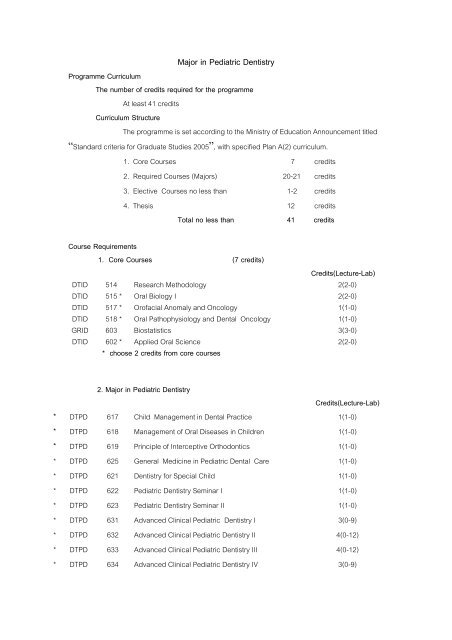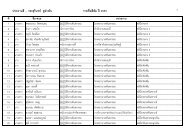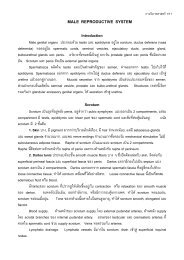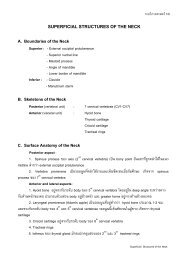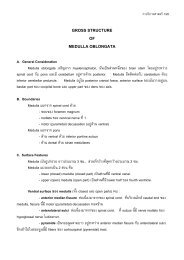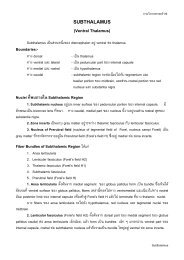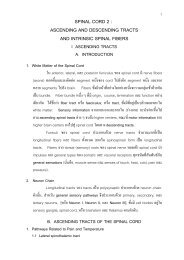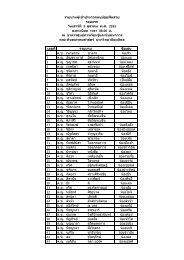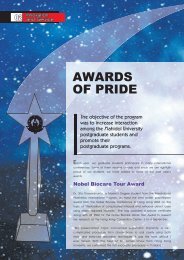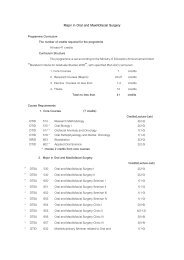Major in Pediatric Dentistry
Major in Pediatric Dentistry
Major in Pediatric Dentistry
You also want an ePaper? Increase the reach of your titles
YUMPU automatically turns print PDFs into web optimized ePapers that Google loves.
<strong>Major</strong> <strong>in</strong> <strong>Pediatric</strong> <strong>Dentistry</strong><br />
Programme Curriculum<br />
The number of credits required for the programme<br />
At least 41 credits<br />
Curriculum Structure<br />
The programme is set accord<strong>in</strong>g to the M<strong>in</strong>istry of Education Announcement titled<br />
“Standard criteria for Graduate Studies 2005”, with specified Plan A(2) curriculum.<br />
1. Core Courses 7 credits<br />
2. Required Courses (<strong>Major</strong>s) 20-21 credits<br />
3. Elective Courses no less than 1-2 credits<br />
4. Thesis 12 credits<br />
Total no less than 41 credits<br />
Course Requirements<br />
1. Core Courses (7 credits)<br />
Credits(Lecture-Lab)<br />
DTID 514 Research Methodology 2(2-0)<br />
DTID 515 * Oral Biology I 2(2-0)<br />
DTID 517 * Orofacial Anomaly and Oncology 1(1-0)<br />
DTID 518 * Oral Pathophysiology and Dental Oncology 1(1-0)<br />
GRID 603 Biostatistics 3(3-0)<br />
DTID 602 * Applied Oral Science 2(2-0)<br />
* choose 2 credits from core courses<br />
2. <strong>Major</strong> <strong>in</strong> <strong>Pediatric</strong> <strong>Dentistry</strong><br />
Credits(Lecture-Lab)<br />
* DTPD 617 Child Management <strong>in</strong> Dental Practice 1(1-0)<br />
* DTPD 618 Management of Oral Diseases <strong>in</strong> Children 1(1-0)<br />
* DTPD 619 Pr<strong>in</strong>ciple of Interceptive Orthodontics 1(1-0)<br />
* DTPD 625 General Medic<strong>in</strong>e <strong>in</strong> <strong>Pediatric</strong> Dental Care 1(1-0)<br />
* DTPD 621 <strong>Dentistry</strong> for Special Child 1(1-0)<br />
* DTPD 622 <strong>Pediatric</strong> <strong>Dentistry</strong> Sem<strong>in</strong>ar I 1(1-0)<br />
* DTPD 623 <strong>Pediatric</strong> <strong>Dentistry</strong> Sem<strong>in</strong>ar II 1(1-0)<br />
* DTPD 631 Advanced Cl<strong>in</strong>ical <strong>Pediatric</strong> <strong>Dentistry</strong> I 3(0-9)<br />
* DTPD 632 Advanced Cl<strong>in</strong>ical <strong>Pediatric</strong> <strong>Dentistry</strong> II 4(0-12)<br />
* DTPD 633 Advanced Cl<strong>in</strong>ical <strong>Pediatric</strong> <strong>Dentistry</strong> III 4(0-12)<br />
* DTPD 634 Advanced Cl<strong>in</strong>ical <strong>Pediatric</strong> <strong>Dentistry</strong> IV 3(0-9)
2<br />
* new courses<br />
TOTAL 21<br />
3. Elective Courses (at least 1-2 credits)<br />
Credits(Lecture-Lab)<br />
* DTAN 541 Extracellular Matrices and M<strong>in</strong>eralized Tissues 1(1-0)<br />
DTAN 601 Applied Anatomy of Head and Neck 1(1-0)<br />
* DTBC 540 Molecular Biology <strong>in</strong> <strong>Dentistry</strong> 1(1-0)<br />
DTHD 692 Cl<strong>in</strong>ical Photography 1(1–0)<br />
DTHD 693 Computer <strong>in</strong> <strong>Dentistry</strong> 1(1-0)<br />
* DTID 601 Neurobiology of Pa<strong>in</strong> 1(1-0)<br />
* DTID 550 Laboratory Techniques <strong>in</strong> Oral Science 1(0-3)<br />
* DTID 603 Pr<strong>in</strong>ciple Techniques <strong>in</strong> Oral Science 1(1-0)<br />
* DTID 604 Physiology of the Dental Pulp 1(1-0)<br />
* DTID 606 Oral Physiology 1(1-0)<br />
* DTID 608 Multidiscipl<strong>in</strong>ary Sem<strong>in</strong>ar 1 (1-0)<br />
* DTID 609 Oral Photography 1(1-0)<br />
* DTID 610 Fundamentals of Dental Biomaterials 1(1-0)<br />
DTID 624 Laboratory Techniques <strong>in</strong> Oral Biology Research 2(2-0)<br />
* DTID 633 Test<strong>in</strong>g Methods for Dental Biomaterials Research 1(1-0)<br />
DTID 625 Us<strong>in</strong>g Statistical Software for Dental Research 1(0-3)<br />
* DTID 630 Computer Application <strong>in</strong> Dental Education 1(0-3)<br />
* DTID 631 Psychology and Professional Ethics 1(1-0)<br />
* DTMD 675 Dental Implant 1(1-0)<br />
* DTMI 613 Microbiological Techniques <strong>in</strong> Oral Science 1(0-3)<br />
* DTMI 614 Dental Microbiology and Immunology 1(1-0)<br />
* DTMI 615 Immunological Aspects of Oral Diseases 1(1-0)<br />
DTOP 676 Applied Operative <strong>Dentistry</strong> 2(1-3)<br />
* DTPA 612 Oral Pathology 1(1-0)<br />
* DTPD 626 Sem<strong>in</strong>ar <strong>in</strong> <strong>Pediatric</strong> Patient Care 1(1-0)<br />
* DTPM 610 Pharmacology and Dental Therapeutics 1(1-0)<br />
DTPT 500 Craniofacial and Body Prostheses 1(1-0)<br />
DTPT 505 Maxillofacial Prosthetic and Dental Oncology Sem<strong>in</strong>ar I 2(2-0)<br />
* DTPT 640 Maxillofacial Prosthetic and Dental Oncology Cl<strong>in</strong>ic I 2(0-6)<br />
* DTPT 641 Maxillofacial Prosthetic and Dental Oncology Cl<strong>in</strong>ic II 2(0-6)<br />
* DTPT 642 Maxillofacial Prosthetic and Dental Oncology Cl<strong>in</strong>ic III 2(0-6)<br />
* DTPT 643 Basic to Advanced Prosthodontics I 2(2-0)<br />
* DTPT 644 Basic to Advanced Prosthodontics II 1(1-0)
3<br />
4. Thesis (12 credits)<br />
Credits(Lecture-Lab)<br />
DTPD 698 Thesis 12(0–36)<br />
Study Plan <strong>Major</strong> <strong>in</strong> <strong>Pediatric</strong> <strong>Dentistry</strong><br />
Year Semester 1 Semester 2<br />
1 DTID 514 Research Methodology 2(2-0) DTPD 619 Pr<strong>in</strong>ciple of Interceptive 1(1-0)<br />
Orthodontics<br />
DTID 515 Oral Biology I 2(2-0) DTPD 621 <strong>Dentistry</strong> for Special 1(1-0)<br />
Child<br />
GRID 603 Biostatistics 3(3-0) DTPD 622 <strong>Pediatric</strong> <strong>Dentistry</strong> 1(1-0)<br />
Sem<strong>in</strong>ar I<br />
DTPD 617 Child Management<br />
1(1-0) DTPD 625 General Medic<strong>in</strong>e <strong>in</strong> 1(1-0)<br />
<strong>in</strong> Dental Practice<br />
<strong>Pediatric</strong> Dental Care<br />
DTPD 618 Management of Oral<br />
1(1-0) DTPD 632 Advanced Cl<strong>in</strong>ical 4(0-12)<br />
Diseases <strong>in</strong> Children<br />
<strong>Pediatric</strong> <strong>Dentistry</strong> II<br />
DTPD 631 Advanced Cl<strong>in</strong>ical<br />
<strong>Pediatric</strong> <strong>Dentistry</strong> I<br />
3(0-9) Elective 1<br />
Total 12 credits<br />
Total 9 credits<br />
2 DTPD 623 <strong>Pediatric</strong> <strong>Dentistry</strong><br />
1(1-0) DTPD 634 Advanced Cl<strong>in</strong>ical 3(0-9)<br />
Sem<strong>in</strong>ar II<br />
<strong>Pediatric</strong> <strong>Dentistry</strong> IV<br />
DTPD 633 Advanced Cl<strong>in</strong>ical<br />
4(0-12) DTPD 698 Thesis 6(0-18)<br />
<strong>Pediatric</strong> <strong>Dentistry</strong> III<br />
DTPD 698 Thesis 6(0-18)<br />
Total 11 credits Total 9 credits<br />
Course Description<br />
1. Core Courses<br />
Credits(Lecture-Lab)<br />
DTID 514 Reseach Methodology 2(2 - 0)<br />
Pr<strong>in</strong>ciple of health science research, research methodology for laboratory research<br />
and applied research e.g. cl<strong>in</strong>ical research and epidemiological research, research designs,<br />
research proposal writ<strong>in</strong>g, hypothesis test<strong>in</strong>g, data collection and manipulation, scientific paper<br />
critique, research statistics, research ethics, report writ<strong>in</strong>g.<br />
DTID 515 Oral Biology I 2(2 - 0)<br />
Development, structure, biology and function of oral tissues and related organs <strong>in</strong><br />
healthy and pathological status. Microbiology <strong>in</strong> oral cavity. Host immune responses. Dental pa<strong>in</strong><br />
and dental hypersensitivity. Update common drugs used <strong>in</strong> dental practice.
4<br />
Credits(Lecture-Lab)<br />
DTID 517 Orofacial Anomaly and Oncology 1(1-0)<br />
The fundamental studies of embryology, physiology, and oncology related to<br />
craniofacial deformities. Pr<strong>in</strong>cipal and theoretical foundations of the causes of craniofacial anomaly<br />
such as cleft lip and palate, differentiation of oral cancer, and others. Specification and<br />
classifications of both systemic and localized diseases, related to head and neck rehabilitation,<br />
multiple therapeutic regimens.<br />
DTID 518 Oral Pathophysiology and Dental Oncology 1(1–0)<br />
Anatomical structures of head and neck <strong>in</strong>clud<strong>in</strong>g histological perspectives as well<br />
and the <strong>in</strong>terrelated organs. The orig<strong>in</strong> of tumors, both benign and malignant, and surgical<br />
<strong>in</strong>terventions <strong>in</strong>volved with cancer therapies, hematologic diseases and therapies <strong>in</strong>volved <strong>in</strong> relation<br />
to oral management, irradiated tissue structures and orofacial therapies.<br />
DTID 602 Applied Oral Sciences 2(2-0)<br />
Anatomy and histology of oral and related structure, masticatory system, differential<br />
diagnosis of oral lesion related to dental prostheses, <strong>in</strong>flammation and wound heal<strong>in</strong>g, allergic<br />
reaction of oral mucosa, tissue reaction to implant, structure and pathogenesis of periodontium,<br />
dental pulp and periapical tissue, biology of bone, benign and malignant lesions that related to<br />
denture, oral manifestation of systemic diseases, normal oral flora and ecology, biology and<br />
pathogenesis of Candida species, antifungal agents <strong>in</strong> the treatment of oral candidosis, analgesics,<br />
dental and orofacial pa<strong>in</strong> and management of pa<strong>in</strong>, and pharmacological effect on oral tissue.<br />
GRID 603 Biostatistics 3(3-0)<br />
The basic knowledge on statistic as population and sample, analysis of data,<br />
measures of central tendency, measures of dispersion, descriptive statistics, probability of sample,<br />
probability distributions, standard error, estimation, hypothesis test<strong>in</strong>g, analysis of variance, l<strong>in</strong>ear<br />
regression and correlation, nonparametric statistical analysis based on medical data. The application<br />
of biostatistics to medical research and related work.
5<br />
2. Required Courses (<strong>Major</strong>)<br />
<strong>Major</strong> <strong>in</strong> <strong>Pediatric</strong> <strong>Dentistry</strong><br />
Credits(Lecture-Lab)<br />
DTPD 617 Child Management <strong>in</strong> Dental Practice 1(1-0)<br />
Child physically, <strong>in</strong>tellectual psycho-social and emotional developments, basic to<br />
advanced behavioral management and techniques, and parental approaches.<br />
DTPD 618 Management of Oral Diseases <strong>in</strong> Children 1(1-0)<br />
Pr<strong>in</strong>ciples and techniques of exam<strong>in</strong>ation, diagnosis, treatment plann<strong>in</strong>g and dental<br />
treatment <strong>in</strong> the area of caries prevention, restoration, dental pulp therapy, traumatic dental <strong>in</strong>juries<br />
and oral surgery <strong>in</strong> pediatric dental patients.<br />
DTPD 619 Pr<strong>in</strong>ciple of Interceptive Orthodontics 1(1-0)<br />
Growth and development of naso-maxillary complex, normal and abnormal<br />
development of primary and mixed dentition, growth modification, concept of preventive and<br />
<strong>in</strong>terceptive orthodontics, orthodontic diagnosis, orthodontic records, orthodontic treatment plann<strong>in</strong>g,<br />
removable and simple fixed orthodontic appliances.<br />
DTPD 625 General Medic<strong>in</strong>e <strong>in</strong> <strong>Pediatric</strong> Dental Care 1(1-0)<br />
Common medical conditions and disabilities <strong>in</strong> pediatric dental patients, oral<br />
manifestations related to the diseases, and precautions dur<strong>in</strong>g the dental treatment.<br />
DTPD 621 <strong>Dentistry</strong> for Special Child 1(1-0)<br />
Dental management <strong>in</strong> medically compromised children, children with physical<br />
disabilities, and patients with mental disabilities, behavior disturbances; hospital dentistry;<br />
management of essential medical emergency.<br />
DTPD 622 <strong>Pediatric</strong> <strong>Dentistry</strong> Sem<strong>in</strong>ar I 1(1-0)<br />
Current literatures related to pediatric dentistry e.g. behavior management, dental<br />
caries, caries prevention, dental materials, restoration and trauma.<br />
DTPD 623 <strong>Pediatric</strong> <strong>Dentistry</strong> Sem<strong>in</strong>ar II 1(1-0)<br />
Students provide the current best answer to the cl<strong>in</strong>ical questions about etiology,<br />
prognosis and treatment <strong>in</strong> pediatric dentistry us<strong>in</strong>g best available evidences <strong>in</strong> mak<strong>in</strong>g decision.<br />
The summary will be presented and all attendances will participate <strong>in</strong> discussion on these evidence<br />
based practices.
6<br />
Credits(Lecture-Lab)<br />
DTPD 631 Advanced Cl<strong>in</strong>ical <strong>Pediatric</strong> <strong>Dentistry</strong> I 3(0-9)<br />
Ethically cl<strong>in</strong>ical pediatric dental practices <strong>in</strong>volve <strong>in</strong> exam<strong>in</strong>ation, diagnosis,<br />
treatment plann<strong>in</strong>g, comprehensive treatments of oral diseases as well as dental caries prevention<br />
and oral health promotion <strong>in</strong> children requir<strong>in</strong>g non-pharmacological behavior management<br />
approach.<br />
DTPD 632 Advanced Cl<strong>in</strong>ical <strong>Pediatric</strong> <strong>Dentistry</strong> II 4(0-12)<br />
An advanced ethically cl<strong>in</strong>ical pediatric dental practice course designed to provide<br />
the students with an opportunity to diagnose oral diseases and malocclusion, develop treatment plan<br />
and deliver comprehensive care <strong>in</strong>clud<strong>in</strong>g treatment of traumatic dental <strong>in</strong>juries and orthodontic<br />
m<strong>in</strong>or tooth movement <strong>in</strong> children.<br />
DTPD 633 Advanced Cl<strong>in</strong>ical <strong>Pediatric</strong> <strong>Dentistry</strong> III 4(0-12)<br />
Ethically cl<strong>in</strong>ical pediatric dental practices <strong>in</strong>volve <strong>in</strong> exam<strong>in</strong>ation, diagnosis,<br />
treatment plann<strong>in</strong>g, comprehensive treatments of oral diseases as well as dental caries prevention<br />
and oral health promotion <strong>in</strong> special care need children requir<strong>in</strong>g non-pharmacological behavior<br />
management approach.<br />
DTPD 634 Advanced Cl<strong>in</strong>ical <strong>Pediatric</strong> <strong>Dentistry</strong> IV 3(0-9)<br />
Cl<strong>in</strong>ical experiences and skills will be established through a comprehensive patient<br />
care <strong>in</strong> children and handicapped with <strong>in</strong>tegration of cl<strong>in</strong>ical discipl<strong>in</strong>es <strong>in</strong> the provision of<br />
comprehensive/holistic care to meet patients need. It is also devoted to provid<strong>in</strong>g children with<br />
urgent or comprehensive oral and dental care under levels of pa<strong>in</strong> and anxiety control from<br />
conscious sedation to general anesthesia. A brief anesthesia rotation and a review of basic life<br />
support are <strong>in</strong>cluded. Participation <strong>in</strong> pre-doctoral dental students teach<strong>in</strong>g provid<strong>in</strong>g <strong>in</strong>struction and<br />
cl<strong>in</strong>ical supervision is an <strong>in</strong>tegral part of this cl<strong>in</strong>ical course.<br />
3. Elective Courses<br />
Credits(Lecture-Lab)<br />
DTAN 541 Extracellular Matrices and M<strong>in</strong>eralized Tissues 1(1-0)<br />
Structure and functions of connective tissue. The biosynthesis of fibrous elements,<br />
collagen, elast<strong>in</strong>, and the glycosam<strong>in</strong>oglycan. Biochemistry of organic matrices and the m<strong>in</strong>eralized<br />
component of bone and teeth. The normal endocr<strong>in</strong>e regulation of bone metabolism, bone <strong>in</strong>duction,<br />
growth and remodel<strong>in</strong>g. Various molecular and cellular events of pathological processes, <strong>in</strong>volv<strong>in</strong>g<br />
connective tissue <strong>in</strong> general and craniofacial region <strong>in</strong> particular.
7<br />
Credits(Lecture-Lab)<br />
DTAN 601 Applied Anatomy of Head and Neck 1(1-0)<br />
Structures and functions of human head and neck, focused on craniofacial and<br />
related structures to apply for advanced cl<strong>in</strong>ical approaches.<br />
DTBC 540 Molecular Biology <strong>in</strong> Dentisry 1(1-0)<br />
Introduction to basic molecular biology. Study of cell components <strong>in</strong>clud<strong>in</strong>g genes,<br />
molecular genetics, prote<strong>in</strong> synthesis, gene clon<strong>in</strong>g, regulation of gene expression, basic pr<strong>in</strong>ciples<br />
of molecular biology techniques and its application <strong>in</strong> the field of dentistry.<br />
DTHD 692 Cl<strong>in</strong>ical Photography 1(1-0)<br />
General pr<strong>in</strong>ciples of photography, selection of cameras, lens, films, facial and<br />
<strong>in</strong>traoral photography, film process<strong>in</strong>g, slide production and computer aids for presentation.<br />
DTHD 693 Computer <strong>in</strong> <strong>Dentistry</strong> 1(1-0)<br />
Study on computer and its supportive system and accessory equipment such as<br />
scanner, digital camera for application <strong>in</strong> dentistry. Use of computer <strong>in</strong> search<strong>in</strong>g for medical<br />
<strong>in</strong>formation and management of retrieved data. Creation of graphics and media for communication<br />
<strong>in</strong>clud<strong>in</strong>g development of dental service through computer system.<br />
DTID 601 Neurobiology of Pa<strong>in</strong> 1(1-0)<br />
Neurobiology of pa<strong>in</strong> sensation. Peripheral and central mechanisms of pa<strong>in</strong>, The<br />
pathophysiology of damage perpheral nerves, The psychological aspects of pa<strong>in</strong>, Pa<strong>in</strong> assessments<br />
<strong>in</strong> animal and man, Mechanism and management of orofacial pa<strong>in</strong>.<br />
DTID 550 Laboratory Techniques <strong>in</strong> Oral Science 1(0-3)<br />
Laboratory practice <strong>in</strong> techniques currently used <strong>in</strong> oral biology research.<br />
DTID 603 Pr<strong>in</strong>ciple Techniques <strong>in</strong> Oral Science 1(1-0)<br />
Basic pr<strong>in</strong>ciples, theory of techniques currently used <strong>in</strong> oral biology research.<br />
DTID 604 Physiology of the Dental Pulp 1(1-0)<br />
Macro and microcirculation of the dental pulp, Methods used for measur<strong>in</strong>g the<br />
pulp tissue fluid pressure, Physiology of the pulpo-dent<strong>in</strong>e complexes, Physiology of the pulp <strong>in</strong><br />
normal and <strong>in</strong>flammatory stages, Neurophysiology of the dental pulp, Dent<strong>in</strong>e hypersensitivity
8<br />
Credits(Lecture-Lab)<br />
DTID 606 Oral Physiology 1(1-0)<br />
Neurophysiology of oral sensorimotor system, basic understand<strong>in</strong>g of the sensory<br />
and motor system of orofacial region <strong>in</strong>clud<strong>in</strong>g orofacial pa<strong>in</strong> mechanism<br />
DTID 608 Multidiscipl<strong>in</strong>ary Sem<strong>in</strong>ar 1(1-0)<br />
A one-hour weekly sem<strong>in</strong>ar, a "multi-use" course with<strong>in</strong> the graduate dental<br />
curriculum, viewed as an enrichment opportunity to relate develop<strong>in</strong>g expertise to a comprehensive<br />
dental care sett<strong>in</strong>g, specifically designed to accommodate and promote evidence-based, multidiscipl<strong>in</strong>ary<br />
<strong>in</strong>teraction among advanced education students <strong>in</strong>volved <strong>in</strong> cl<strong>in</strong>ical patient care.<br />
DTID 609 Oral Photography 1(1-0)<br />
Knowledge of varieties component of regular and digital camera <strong>in</strong>clud<strong>in</strong>g film and<br />
lens. Students are able to take good photograph for presentation<br />
DTID 610 Fundamentals of Dental Biomaterials 1(1-0)<br />
The structure, chemistry, properties and handl<strong>in</strong>g of metallic, ceramic, polymer,<br />
and composite materials used for dental and medical applications. Recent advances <strong>in</strong> the<br />
development of dental biomaterials, technology and devices.<br />
DTID 624 Laboratory Techniques <strong>in</strong> Oral Biology Research 2(2-0)<br />
Theory of sample preparation, <strong>in</strong>struction <strong>in</strong> the operation of research <strong>in</strong>struments<br />
and modern techniques currently used <strong>in</strong> oral biology research. Techniques covered <strong>in</strong>clude<br />
spectroscopy, ion analysis, centrifugation, cell culture, separation and analysis by chromatography,<br />
electrophoresis, microbiological techniques, immunological techniques, Laser Doppler technique,<br />
scann<strong>in</strong>g electron microscopy and basic pr<strong>in</strong>ciples of molecular biology techniques as well as<br />
<strong>in</strong>terpretation of results.<br />
DTID 633 Test<strong>in</strong>g Methods for Dental Biomaterials Research 1(1-0)<br />
Basic concepts, pr<strong>in</strong>ciples and techniques commonly used <strong>in</strong> <strong>in</strong> vivo and <strong>in</strong> vitro<br />
study <strong>in</strong> research <strong>in</strong>clud<strong>in</strong>g dental biomaterials, m<strong>in</strong>eralized tissues, oral hygiene products and<br />
<strong>in</strong>struments.
9<br />
Credits(Lecture-Lab)<br />
DTID 625 Us<strong>in</strong>g Statistical Software for Dental Research 1(0-3)<br />
Computer practice us<strong>in</strong>g a statistical computer software, such as SPSS, to carry out<br />
data analysis, <strong>in</strong>terpretation and presentation. Work<strong>in</strong>g knowledge of some selected statistical<br />
techniques commonly used <strong>in</strong> cl<strong>in</strong>ical and cl<strong>in</strong>ically related laboratory research and design of a<br />
research project with the appropriate statistical <strong>in</strong>vestigation is also provided.<br />
DTID 630 Computer Application <strong>in</strong> Dental Education 1(0-3)<br />
Applied computer <strong>in</strong> dentistry, search<strong>in</strong>g literature, database, graphic<br />
management, presentation program and thesis writ<strong>in</strong>g.<br />
DTID 631 Psychology and Ethics for Dentists 1(1-0)<br />
Study of psychology of dental patients focuses on the doctor-patient relationship as<br />
well as the physician’s relationship to society and colleagues lead<strong>in</strong>g to establish morality human<br />
values and <strong>in</strong>nermost feel<strong>in</strong>g promote the importance of listen<strong>in</strong>g, observ<strong>in</strong>g, and car<strong>in</strong>g for the<br />
patients.<br />
DTMD 675 Dental Implant 1(1-0)<br />
Scientific basis of dental implant, surgical periodontal and prosthetic consideration<br />
<strong>in</strong> implant dentistry diagnosis and treatment plan, complication and ma<strong>in</strong>tenance of implant patients.<br />
DTMI 613 Microbiological Techniques <strong>in</strong> Oral Science 1(0-3)<br />
Laboratory exercises and experiments concern<strong>in</strong>g methods used <strong>in</strong> Oral<br />
Microbiology and Immunology research. Detection and identification of oral bacteria by cultivation,<br />
i.e., cariogenic bacteria, periodontal bacteria, Candida. Caries activity tests. Detection and<br />
identification of oral bacteria by non-cultur<strong>in</strong>g methods, i.e., DNA probe analyses, PCR,<br />
immunological assays, i.e., immunofluorescence, flow cytometry, ELISA, Western blott<strong>in</strong>g, latex<br />
agglut<strong>in</strong>ation, serological assays. Application<br />
DTMI 614 Dental Microbiology and Immunology 1(1-0)<br />
Ecology of oral microflora. Oral biofilms and roles <strong>in</strong> oral <strong>in</strong>fections.<br />
Microorganisms responsible for dental caries, periodontal disease and other important oral<br />
<strong>in</strong>fections. Immune responses aga<strong>in</strong>st oral pathogens.
10<br />
Credits(Lecture-Lab)<br />
DTMI 615 Immunological Aspects of Oral Diseases 1(1-0)<br />
Basic structure of immunoglobul<strong>in</strong>s. Immunoglobul<strong>in</strong> classes. Immunity to<br />
<strong>in</strong>fections; <strong>in</strong>nate and acquired immunity. Oral immunity; oral lymphoid tissues, saliva and secretory<br />
IgA, g<strong>in</strong>gival crevicular fluid. Immunology of dental caries. Immunology of periodontal disease.<br />
Immunology of oral candidiasis. Immunology of viral <strong>in</strong>fections. Immunization<br />
DTOP 676 Applied Operative <strong>Dentistry</strong> 2(1-3)<br />
The theories of various restorative treatments <strong>in</strong>clud<strong>in</strong>g materials and techniques<br />
used and evaluation methods of the restorations after treatment are studied <strong>in</strong> this course. Laboratory<br />
practice on these techniques is <strong>in</strong>cluded.<br />
DTPA 612 Oral Pathology 1(1-0)<br />
Pr<strong>in</strong>ciple of oral diagnosis, laboratory technique and <strong>in</strong>terpretation, forensic science<br />
and oral biology, diseases of salivary gland, connective tissue and bone, abnormal craniofacial<br />
development, oral cancer, oral lesions <strong>in</strong> elderly and hormone deficiency and oral immunopathology<br />
DTPD 626 Sem<strong>in</strong>ar <strong>in</strong> <strong>Pediatric</strong> Patient Care 1(1-0)<br />
The course affords the opportunity to share variety of the patients’ challeng<strong>in</strong>g<br />
behavioral/dental/ medical problems and limitations through case presentation and discussion based<br />
on current cl<strong>in</strong>ical pr<strong>in</strong>ciples/concepts of dental care <strong>in</strong> children.<br />
DTPM 610 Pharmacology and Dental Therapeutics 1(1-0)<br />
Pr<strong>in</strong>ciple of cl<strong>in</strong>ical pharmacology. Experimental therapeutics and rationale<br />
<strong>in</strong>troduction of new drugs. Drugs for prevention and treatment of oral diseases, such as<br />
antimicrobial agents, anti-<strong>in</strong>flammatory drugs, analgesics, local anesthetics, neuromuscular block<strong>in</strong>g<br />
agents and CNS drugs. Adverse drug reactions affect<strong>in</strong>g the mouth and associated structures.<br />
DTPT 500 Craniofacial and Body Prostheses 1(1-0)<br />
The use and selection of materials <strong>in</strong> relation to fabrication of craniofacial and<br />
body prostheses. The various technical processes <strong>in</strong>volved from impression, mold<strong>in</strong>g formulation,<br />
process<strong>in</strong>g prosthesis will be discussed. Case selections and design of different types of prosthesis<br />
for any <strong>in</strong>dicated defects will be extensively expla<strong>in</strong>ed <strong>in</strong> detail.
11<br />
Credits(Lecture-Lab)<br />
DTPT 505 Maxillofacial Prosthetic and Dental Oncology Sem<strong>in</strong>ar I 2(2-0)<br />
The sem<strong>in</strong>ars <strong>in</strong> maxillofacial prosthetic and dental oncology topics are<br />
ma<strong>in</strong>ly concentrated <strong>in</strong> both classical and recent research literatures. The discussions are<br />
based upon selected topics <strong>in</strong> historical perspective concepts and modern research<br />
methodology. Reviewed articles are also divided <strong>in</strong>to various related fields such as<br />
maxillofacial prosthetics, maxillofacial surgery, orthodontics, psychological issues that have<br />
their relevancy <strong>in</strong> treat<strong>in</strong>g cranio – and orofacial deformed patients.<br />
DTPT 640 Maxillofacial Prosthetic and Dental Oncology Cl<strong>in</strong>ic I 2(0-6)<br />
Ethically cl<strong>in</strong>ical practice with diagnosis and treatment plann<strong>in</strong>g for congenital<br />
and acquired cranio – and orofacial defect patients. Practice <strong>in</strong>clud<strong>in</strong>g a basic dental<br />
treatment, emergency treatment, and others.<br />
DTPT 641 Maxillofacial Prosthetic and Dental Oncology Cl<strong>in</strong>ic II 2(0-6)<br />
Ethically cl<strong>in</strong>ical practice on patients with cancer therapies, such as radiation,<br />
chemotherapy, or surgical procedure.<br />
DTPT 642 Maxillofacial Prosthetic and Dental Oncology Cl<strong>in</strong>ic III 2(0-6)<br />
Maxillofacial defect patients exam<strong>in</strong>ed and treated ethically. Prosthetic<br />
treatments ma<strong>in</strong>ly concentrated on complicated <strong>in</strong>traoral defects.<br />
DTPT 643 Basic to Advanced Prosthodontics I 2(2-0)<br />
Introduction to the basic understand<strong>in</strong>g of prosthodontics and the progress <strong>in</strong>to<br />
advance restoration to ma<strong>in</strong>ta<strong>in</strong> oral function <strong>in</strong> an optimal masticatory processes. Cl<strong>in</strong>ical care for<br />
complete and partial edentulism. Standardized care <strong>in</strong> both removable and fixed restoration prior to<br />
study more complicated procedures of dental prostheses.<br />
DTPT 644 Basic to Advanced Prosthodontics II 1(1-0)<br />
Cont<strong>in</strong>uation of basic to advance dental therapies to obta<strong>in</strong> and optimal masticatiry<br />
function us<strong>in</strong>g more complicated therapies such as implant retaired prosthesis.<br />
19.6.4 Thesis 12 credits<br />
<strong>Major</strong> <strong>in</strong> <strong>Pediatric</strong> <strong>Dentistry</strong><br />
DTPD 698 Thesis 12(0–36)<br />
Dental caries prevention, <strong>Dentistry</strong> for special child, Occlusion development,<br />
Restorative <strong>in</strong> primary teeth, Dental pulp therapy <strong>in</strong> primary teeth, Dental trauma, Biology of dental<br />
plaque, and Child management


